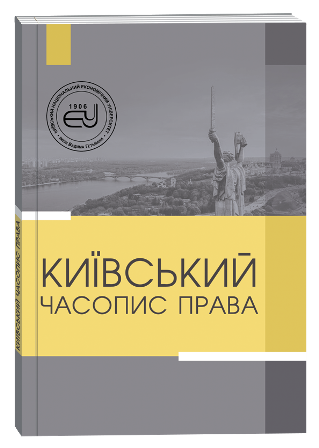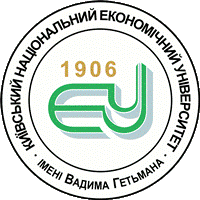STATE AND LEGAL DEVELOPMENT OF THE ROMAN EMPIRE IN THE PERIOD OF DOMINATE: LEX FOEDUS AND LEGAL PERSONALITY OF THE EASTERN AND WESTERN PARTS OF IMPERIUM
DOI:
https://doi.org/10.32782/klj/2024.2.1Keywords:
legal personality, foederatio, Roman Empire, dominate, tetrarchy, Augustus, Eastern Roman Empire, Western Roman Empire, lex foedusAbstract
The proposed article is designed to highlight and analyze the key features of the state & legal evolution of the Roman Empire during the period of the so-called “dominate”. It means the period of 284-480 AD when the emperors concentrated administrative influence in their hands. At that moment, Augusti expanded their jurisdiction in the field of direct administration of the provinces. Instead, the powers of the Roman Senate were nominalized. Roman Empire de jure preserved the features of the republican form of government. So, according to the legislation, the emperors ruled the “republic”. At the same time, more fundamental signs of the “foederal” form of the state system appeared during the period of dominate. During 284-480 AD, the evolution of Roman federalism was strongly connected with the legal technique of interaction between emperors and barbarian tribes. The empire actively “granted” barbarian rulers the status of “foederati”. After serious barbarian invasions of Roman territory (376 AD and 406 AD), the legal regime of the lex foedus began to fulfill the function of protecting the ephemeral power of the Western Roman emperors in the lost lands. As one of the “exits” for themselves, the Roman Augusti recognized the possibility of “granting” the barbarian “kings” foederal status, which legalized their political structures within the imperial political and legal system. The agreements on “foederal” status signed by the Roman emperors with the Visigoths in Lower Moesia (382 AD) and Aquitaine (418 AD) should be recognized as a classic. During the 5th century AD, the Roman Empire included the “barbarian kingdoms” of the Visigoths, Burgundians, Vandals, Suevians, Alemannians, Ostrogoths, etc. All these political entities recognized the supreme power of the Western or Eastern Roman emperors. After the assassination of Julius Nepos (480 AD), the barbarian kings proclaimed the Eastern Roman ruler Zeno (476-491 AD) as their “only” emperor. Therefore, the Roman Empire did not “collapse”, but continued its historical existence with the capital in the official “Nova Roma” (Constantinople). Accordingly, the constitution and functioning of the “East” and “West” of the Roman Empire appear to be a significant historical & legal problem.
References
Лоський Костянтин. Нарис римської історії. К.: Центр учбової літератури, 2021. 146 с.
Rees Roger. Diocletian and the Tetrarchy. Edinburgh: Edinburgh University Press, 2004. XVI+219 pp.
Waldron Byron. Dynastic Politics in the Age of Diocletian (AD 284-311). Edinburgh: Edinburgh University Press, 2022. XXII+274 pp.
Kolb F. Diocletian und die Erste Tetrarchie: Improvisation oder Experiment in der Organisation monarchischer Herrschaft? Berlin-New York: De Gruyter, 1987. IX+205 s.
Мельник В. М. Республіканський характер Римської імперії: принципат і домінат як публічно-правові режими. // Юридичний вісник. 2023. № 1. С. 21-31.
Hekster Olivier. Rome and its Empire, AD 193-284. Edinburgh: Edinburgh University Press, 2008. XX+183 pp.
Barnes Timothy D. Constantine and Eusebius. Cambridge, Mass.: Harvard University Press, 1981. VI+458 pp.
Pohlsander Hans. The Emperor Constantine. London & New York: Routledge, 2004. 144 p.
Мельник В. М. Ідеї міжнародної правосуб’єктності в політичній діяльності та нормативних актах імператора Константина Великого. // Актуальні проблеми політики. 2023. Випуск 72. С. 17-26.
Џомић В. Правна природа слободе вероисповести у Галеријевом и Миланском едикту. // Свети цар Константин и хришћанство. Т. I. Ниш, 2013. С. 359-368.
Marcone Arnaldo. Pagano e cristiano. Vita e mito di Costantino. Bari: GLF editori Laterza, 2002. 228 p.
Шукунда М. Љ., презв. Верска политика Римског Царства од 311-380 године. Београд, 2017. 373 с.
Odahl Charles Matson. Constantine and the Christian Empire. New York: Routledge, 2004. XVIII+400 pp.
Clauss M. The Roman Cult of Mithras: The God and his Mysteries. Edinburgh: Edinburgh University Press, 2000. XXIV+198 pp.
Leadbetter William Lewis. Galerius and the Will of Diocletian. Roman Imperial Biographies. London & New York: Taylor and Francis, 2009. XVI+280 pp.
Watson Alaric. Aurelian and the Third Century. London: Routledge, 2004. XVI+303 pp.
Maškin N. A. Istorija starog Rima. 9-o izd. Beograd: Naučna, 2002. 590 s.
Kettenhofen Erich. Die Eroberung von Nisibis und Karrhai durch die Sāsāniden in der Zeit Kaiser Maximins, AD 235/236. // Iranica Antiqua. 1995. Bd. 30. S. 159-177.
Southern Patricia. The Roman Empire from Severus to Constantine. London: Routledge, 2001. XVI+501 pp.
Farrokh Kaveh. Shadows in the Desert: Ancient Persia at War. Oxford: Osprey Publishing, 2007. 320 p.
Musset Lucien. Les Invasions: les vagues germaniques. Paris: Presses universitaires de France, 1965. 330 p.
Тиліщак Володимир. Готи над Гнізною. Таємниці давнього некрополя. К.: Смолоскип, 2018. 144 с.
Mecella Laura. Dexippo di Atene. Testimonianze e frammenti. Introduzione, edizione, tradizione e commento. Tivoli: Tored Edizioni, 2013. XXXI+678 pp.
Светоній Транквілл Ґай. Життєписи Цезарів. / Переклав з латини Павло Содомора. Львів: Видавництво «Апріорі», 2023. 360 с.
Петречко О. М. Суспільно-політичний розвиток Римської Імперії в І – на початку III ст. н. е.: від «відновленої» Республіки до сенатської монархії. Львів: Видавничий центр ЛНУ імені Івана Франка, 2009. 396 с.
Петречко О. М. Державне управління Риму доби принципату (І – ІІ ст. н. е.). // Проблеми гуманітарних наук. 2006. Випуск ХVIII. С. 114-123.
Timo Stickler: The Foederati. // The Blackwell Companion to the Roman Army. Ed. by Paul Erdkamp. Oxford: Blackwell, 2007. Pp. 495-514.
Weingartner Michael. Liquidating the Independent State Legislature Theory. // Harvard Journal of Law and Public Policy. 2023. Vol. 46. Issue 1. Pp. 135-220.
Мельник В. М. Правосуб’єктність Римської імперії в процесі інституціоналізації домінату: передумови та наслідки тетрархії. // Juris Europensis Scientia. 2023. № 4. С. 7-12.
Doležal Stanislav. Constantine’s Military Operations against the Goths and the Sarmatians in 332 and 334. // Eirene. Studia Graeca et Latina. 2019. Vol. LV. No I-II. Pp. 231-257.
Мельник В. М. Ідеологічні та термінологічні проблеми в римсько-іранській дипломатії часів імператора Константина (324-337 рр.). // Філософія в сучасному науковому та соціально-політичному дискурсах. Матеріали доповідей та виступів IV Всеукраїнської науково-практичної конференції з міжнародною участю (16-17 листопада 2023 року). Вінниця, 2024. С. 112-117.
Brent Allen. Ignatius of Antioch and the Imperial Cult. // Vigiliae Christianae. 1998. Vol. 52. Issue 1. Pp. 30-58.
Congar Yves. Neuf cents ans après: notes sur le “Schisme oriental”. Chevetogne: Éditions de Chevetogne, Monastère de l’Exaltation de la Sainte Croix 1954. 95 p.
Ayres Reseña de Lewis. Nicaea and its Legacy, An Approach to Fourth-Century Trinitarian Theology. Oxford: Oxford University Press, 2006. 496 pp.
Кримський А. Ю. Партія та Аршакіди, звідки їхня держава взялася. / Кримський А. Ю. Вибрані сходознавчі праці в п’яти томах. Том IV Іраністика. К.: Інститут сходознавства НАНУ, 2008. С. 93-236.
де Фріс Вільгельм, Бирля Октавіян, Ґілл Джозеф, Лацко Міхал. Рим і патріярхати Сходу. / Серія «Пам’ятки історично-богословської думки», випуск другий. Переклад з німецької О. Конкевича, С. Матіяш. Львів: Видавництво УКУ, 2015. 416 с.
Eusebius. Life of Constantine. Introduction, translation, and commentary by Averil Cameron and Stuart G. HallCameron. New York: Oxford University Press, 1999. XV+395 pp.
Ammianus Marcellinus. Das römische Weltreich vor dem Untergang. / Sämtliche erhaltene Bücher. Übersetzt von Otto Veh. Eingeleitet und erläutert von Gerhard Wirth. Zürich und München: Artemis, Die Bibliohek der Alten Welt, 1974. XXX+950 s.
The Roman Eastern Frontier and the Persian Wars AD 226-363. A Documentary History. Ed. by Michael H. Dodgeon, Samuel N. C. Lieu. London-New York: Routledge, 1994. XXIII+430 pp.
Smith Kyle. Constantine and the Captive Christians of Persia: Martyrdom and Religious Identity in Late Antiquity. Berkeley: University of California Press, 2016. XXII+232 pp.
Cuneo Paola Ombretta. La legislazione di Costantino II, Costanzo II e Costante (337-361). Milano: Giuffrè, 1997. CXVIII+518 pp.
Lenski Noel Emmanuel. Failure of Empire. Valens and the Roman State in the Fourth Century A. D. Berkeley: University of California Press, 2002. XIV+454 pp.
Bowersock G. W. Julian the Apostate. London: Duckworth, 1978. XII+135 pp.
Emperor and Author: The Writings of Julian the Apostate. / Edited by Nicholas Baker-Brian and Shaun Tougher. Swansea: Classical Press of Wales, 2012. XXI+384 pp.
Ta’rikh al-rusul wa’l-mulnk: The History of Al-Ṭabarī. Vol. V. The Sāsānids, the Byzantines, the Lakmids, and Yemen. Translated and annotated by C. E. Bosworth. Albany: State University of New York Press, Columbia University Center for Iranian Studies, 1999. XXXV+458 pp.
Hunt David. Julian. // The Cambridge Ancient History: The Late Empire. A.D. 337-425. Vol. XIII. Edited by Averil Cameron, Peter Garnsey. Cambridge: Cambridge: University Press, 1998. Рр. 44-77.
Curran John. From Jovian to Theodosius. // The Cambridge Ancient History: The Late Empire. A.D. 337-425. Vol. XIII. Edited by Averil Cameron, Peter Garnsey. Cambridge: Cambridge University Press, 1998. Pp. 78-110.
Hughes Ian. Imperial Brothers. Valentinian, Valens and the Disaster at Adrianople. Barnsley: Pen & Sword, 2013. 282 pp.
Bayless William. The political unity of the Roman Empire during the desintegration of the West, A. D. 395-457. PhD thesis Brown University. Providence, 1972. 218 pp.
Errington Malcolm R. Roman Imperial Policy from Julian to Theodosius. / Studies in the History of Greece and Rome. Chapel Hill: University of North Carolina Press, 2006. XII+336 pp.
Gibbon Edward. The History of the Decline and Fall of the Roman Empire. Volume 1 (AD 180-476). New York: The Modern Library, 1932. IV+2537 pp.
Yilmazata Mehmet. Notes on the Res Gestae and Historiographical Views towards the Battle of Adrianople (378 AD). // Journal of Ancient History and Archaeology. 2018. Vol. 5. Issue 3. Pp. 24-34.
The Ecclesiastical History of Socrates, surnamed Scholasticus, or the Advocate. London: H. Bohn, 1853. XX+475 pp.
Goffart Walter. Barbarian Tides: The Migration Age and the Later Roman Empire. Philadelphia: University of Pennsylvania Press, 2006. X+372 pp.
Heather Peter. The Restoration of Rome: Barbarian Popes and Imperial Pretenders. London: Macmillan, 2013. XVIII+470 pp.+XVI ill.
Bury John Bagnell. History of the Later Roman Empire from the Death of Theodosius I to the Death of Justinian. AD 395 to 565. Volume 1. London: Macmillan & Co., 1923. XXV+471 pp.
Grant Michael. From Rome to Byzantium: The Fifth Century AD. London and New York: Routledge, 1998. XIII+203 pp.
Maspero Jean. Φοιδερᾶτοι et Στρατιῶται dans l’armée byzantine au VI siècle. // Byzantinische Zeitschrift. 1912. Bd. 21. No 1. S. 97-109.







